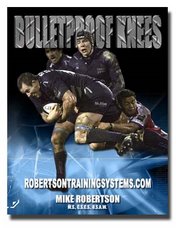Mike,
I just wanted to let you know how much I have enjoyed the program Bulletproof Knees. I feel more confident now dealing with the many clients and the ever present knee pain. Of course that's after the MRI and the all clear from their Doctors.
However, I do have a question for you concerning meniscus repair. I have two clients who have had the surgery and were told not only no squatting or step-ups, but not even the basic quad stretch. On page 61 you made it clear about this. I would appreciate any additional comments.
Again thanks for all your work, I also have your shoulder program, great information. Thanks for your help.
Sincerely,
Ken Dunn NSCA, USPTA
The biggest issue here is the terminology, as there’s a huge difference between a MENSICUS REPAIR and a PARTIAL MENISCECTOMY. Here’s a quick anatomy lesson, for those interested.
The meniscus is a hugely important portion of your knee. Not only is it your primary means of shock absorption, but is also aids in distributing force evenly across the knees and aids in proprioception at the knee joint. A few decades ago (before we understood the importance of the meniscus), it was quite common for doctors to yank the whole thing when it was torn! As you can imagine, the post-surgical results were less than optimal and quality of life rapidly declined in most cases.
Now, on to the types of surgery. Only the outer 1/3rd of the meniscus is vascular, or receives blood. Therefore, this is the only portion of the knee which can actually heal itself. Tears that are in the outer 1/3rd of the meniscus, and which are relatively new, are typically the best candidates for a MENISCAL REPAIR. In this case the surgeon will go in and actually suture the torn pieces together, and then cast/stabilize the knee so that it can’t be moved for several weeks. The biggest pro of this procedure is the fact that, if successful, you’ll have all your meniscus in the future. The biggest con here is that the rehabilitation is much more lengthy, often taking up to 6 months to get someone back to full speed.
In contrast, for older injuries or in tears that occur within in the inner 2/3rd’s of the meniscus, a partial meniscectomy is generally performed. In this case the surgeon will go in and remove the torn segments, and then attempt to smooth out the remaining portions of the meniscus. The pro here is that you can typically bounce back very quickly; once you’ve removed swelling/inflammation at the joint you can typically crank up your training pretty quickly. On the down side, you lose some of the shock-absorbing capacity at the joint, leaving you at increased risk of long-term knee issues such as arthritis.
So understanding the type of surgery here is critical – if your surgeon performed a mensical repair, then that client will not be prepared to train for several weeks after surgery. If they only performed a partial meniscectomy, then let swelling, inflammation, and performance dictate what they can/can’t do. Hopefully the physical therapist that worked with them post-surgery has focused on regaining adequate flexion/extension of the knee – if not, that’s a whole ‘nother blog post!
Mike Robertson
The Most Comprehensive Resource Ever Created for Eliminating Knee Pain.








No comments:
Post a Comment